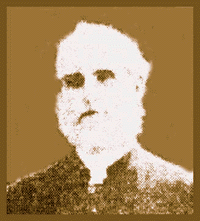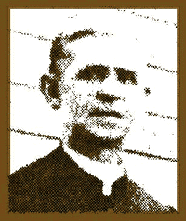|
| NAPARIMA COLLEGE FOREVER |
 |  |
... One cannot enjoy two working lives, but a second, were it possible, would gladly be given to this mission.”
- Rev. John Morton, 1897
Rev. Grant on Naparima
- 1833 Slavery is abolished in the British Empire, (proclaimed in Trinidad in 1838). British-owned sugar plantations in the Caribbean face ruin.
- 1845 First group of indentured labourers arrive in Trinidad from India.
- 1845-1917 Indian immigration continues. 120,000 migrants in total, (exclusive of returnees to India), 90% Hindu, 10% Moslem.
- 1860's Sir Arthur Hamilton Gordon (of Aberdeen and Oxford, Lord Stanmore), former Lieutenant-Governor of New Brunswick, is appointed Governor of Trinidad.
- 1866 Rev. Dr. John Morton, a young Presbyterian minister from the small town of Bridgewater, Nova Scotia, convalescing from a recent illness, arrives in Trinidad on a private trade schooner from his home town. Morton is deeply concerned at the social conditions of the population of 25,000 Indians on plantations. Morton receives approval of the Maritime synod of the Presbyterian church to found a mission to Trinidad. A friend and colleague, Rev. Dr. Kenneth James Grant from Scotch Hill, Pictou County, Nova Scotia, is appointed as a partner in the project.
- 1867 Canada is created as a confederation of provinces under the British North America Act
- 1870 On November 22, Grant, with his newly wed wife Catherine Copeland of Merigomish, Nova Scotia, and Morton with his wife Sarah, arrive in San Fernando, Trinidad.
- 1870's Gordon, Governor of Trinidad, enacts education ordinance facilitating the establishment of Canadian Mission elementary schools. The "C.M." schools, large one-room wooden constructions, are established in a large number of rural communities in Trinidad, and flourish, eventually numbering over seventy.
- 1880 "Four stations [believed to be Tunapuna, San Fernando, Princes Town, Couva] have been established which serve all parts of Trinidad".
- 1883 Rev. Dr. Grant conducts first secondary school classes for his son George, other children of the Mission, and Charles Pasea, by tradition under a samaan tree on Carib Street, San Fernando, near his own home, site of present-day Susamachar Presbyterian Church, and the Grant Memorial (elementary) School.
- 1890 Rev. Dr. Grant receives approval of the church for the establishment of a theological training college. When broached to the Presbyterian Assembly in Ottawa, half of Dr Grant's requested funding is donated by two private families within forty-eight hours. This foundation stone of the ministry in Trinidad is later renamed the Presbyterian Training College and then the St Andrews Theological College.
- 1894 Naparima Training College for Teachers is opened; the secondary school classes to become Naparima College are initially merged with NTC classes.
- 1898 Rev. Grant purchases "Oriental Hall", land and buildings adjacent to his home, which serves for years as a base of operations for the missionaries, and a home for the early Presbyterian College, Naparima Training College, and Naparima College.
- 1900 Naparima College is formally inaugurated, affiliated with Queen's Royal College in Port of Spain, and loosely modelled after Pictou Academy in Pictou, Nova Scotia. Enrolment is 50, staff complement 4.
Rev. Grant reports. - 1904 The first class graduates as holders of the Cambridge School Certificate
- 1917 First buildings are constructed at Paradise Pastures overlooking the Gulf of Paria, immediately to the west of the town of San Fernando, where the institution has stood continuously since.
- 1923 Rev. V. B.Walls of Blackville, New Brunswick is appointed principal, and takes up residence on the hill in January 1924. He would serve for almost 30 years, imprinting Naparima and many individuals with his wit, humanity, gentility, scholarliness, earnestness, steadfastness and traditional Christian values.
Additional buildings are constructed, including a dormitory, a dining hall (1925), an infirmary (1927), and the central part of the "U" design(1931).Establishment of the dormitory was an inspiration. It enabled Naparima to serve a broad area of difficult travel over all of southern Trinidad, from Rio Claro to Chaguanas to Cedros. Even boys who lived close to San Fernando would stay in the dormitory around exam time to enable them to concentrate on their studies. Naturally, the dormitory evolved its own wealth of tradition and stories, and was an unforgettable part of the Naparima experience for the boys who stayed there. A parallel development evolved at La Pique for Naparima Girls with the Sarah Morton Residence (still in use).
- 1930 Rev. Walls spearheads the founding of the Trinidad presbytery of the church, although its formal integration with the Canadian presbytery languishes until 1949.
- 1931 The central part of the old "U" building is built, together with the old science lab, and library. Enrolment stands at 200.
- 1933 Excerpt from a journal of the Mission Council of the Canadian Mission
- 1934 Higher School Certificate (HC) programme inaugurated.
- 1939 First Founders' Day celebration. The wings of the "U" structure are added, replacing two 1917 classrooms.
- 1945 New three-storey dormitory built, remaining in use until the '60's.
- 1950 Naparima's Golden Jubilee, and Rev. Walls' 25th year. A thousand people attend. In the spotlight with Rev. Walls are H.R.H. Princess Alice and the Earl of Athlone; Rev J. C. MacDonald (early principal), Sidney Hogben, Director of Education; Roy Joseph, Mayor; and many dignitaries.
- 1950 The present-day flagstaff, an artifact and gift of Trinidad Leaseholds Limited, is erected and used for the first time, at the Golden Jubilee.
- 1950 St Augustine Girls High School founded in CRH, St Augustine.
- 1953 Rev. Walls retires. The principalship passes to Rev. E. T. Lute of Toronto.
- 1954 A classroom public address system ("the Blue Circle Network") is installed.
- 1954 Permanent sites are secured for Tunapuna and Siparia campuses.
- 1955 17 January: Naparima College, Tunapuna Branch, enrolment 44, at Sheriff St, (in 1961 Hillview); and Naparima College, Siparia Branch, (later Iere) founded.
- 1958 Under Rev. E. T. Lute, new concrete and steel present-day buildings are constructed. The timber from the old 1931 building is used to build a new gymnasium, used until 1995.
- 1958 Rev. Lute introduces the 'house system'. Each student is assigned to a 'house', an artificial group warded by a designated master, and intended to foster comradery, friendly competition, an awareness of our past, and loyalty. Six houses were originally set up, but this number was later reduced to four: Walls House (red); Sammy House (blue); Flemington House (gold); and Grant House (green).
- 1959 The incipient end of British colonial rule is expressed in Trinidad as the first party-controlled general election. National independence looms, and it is evident that many institutions of the past will be passed to local autonomy. Enrolment stands at close to 700.
- 1960 Naparima celebrates its "Diamond Jubilee", the 60th year of its official recognition. Rev. Walls returns from his retirement in New Brunswick for the celebrations.
- 1900 - 1961 All of the Canadian missionaries who founded and built Naparima were remarkable individuals. Often modest and self-effacing in their personal demeanours, they succeeded brilliantly in their aspirations. They lived to see the fruits of their labour, and were each glorified and revered by the individuals to whom they showed the Way, the Truth and the Light.
- 1962 Trinidad & Tobago becomes an independent country. Rev. James Forbes Sieunarine, (named after an early missionary) becomes the first principal to emerge from among the students of the Canadian Mission..
- 1963 The Walls Pavilion is constructed on the playing field off Rushworth St. (Retired 2014).
- 1967 The dormitory is re-furbished as classroom space.
- 1975 On the 13th anniversary of Trinidad & Tobago's independence, Rev. Walls is awarded the Chaconia Gold Medal, Trinidad & Tobago's highest recognition, for his 30 years of service to the country.
In this same year, with characteristic quiet, the United Church Board of Missions formally closes the Canadian Mission to Trinidad.
- 1996 95% of the 120 boys writing the "O" level school-leaving exams secured passes in five or more subjects, the highest percentage of passes among the island's high schools.
- 2000 Former dormitory and dining hall replaced by large new classroom wing.
Naparima builds on its past strengths and continues today as the most preferred secondary school in southern Trinidad.It must be noted that the work of the missionaries was done with the cooperation, and often substantial funding from the government of the island. Also, although education of the Indian community was the original aim of the Canadian mission to Trinidad, all of its schools were founded and integrated within their cosmopolitan local communities. Throughout its history, individuals from all of Trinidad's several ethnic groups attended Naparima, served on its staff, and contributed to its strength and its values.
TOP
Some Notes on the Canadian Mission to Trinidad
Main NC-Forever Page